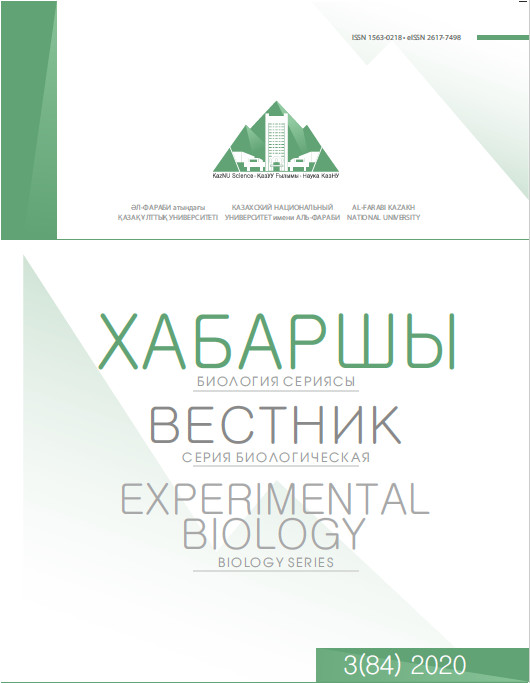Microbiological analysis of phosphorus-containing waste in the southern region
DOI:
https://doi.org/10.26577/eb.2020.v84.i3.04Abstract
The article presents the physical, chemical and microbiological quantitative and qualitative characteristics of phosphorus-containing man-made waste (slags and sludges) of the former Shymkent phosphorus plant in the South of Kazakhstan. The study found that slurries and slags of phosphorus-containing waste have a pH of 6-7,5 and such components as SiO2-quartz, CaCO3 –calcite, and Fe2O3 –hematite predominate in the composition of surface eroded waste. The following groups of microorganisms were identified in the composition of phosphorus waste: micromycetes in quantity (5,4±0,5)×10CFU/g, heterotrophs-in the amount of–(3,8 ±0,3) ×104 CFU/g, phase 1 nitrifiers -108 CFU / g, nitrogen-fixing bacteria-in quantity 90 % fouling of lumps, actinomycetes-in quantity 105 CFU/g, enterobacteria-in quantity 107 CFU/g. Anaerobes in slag samples -3, 8x104 CFU / ml, and in sludge samples -0, 50x102 CFU / ml, that is, the number of anaerobic microorganisms is less than aerobes.Thionic and sulfur-oxidizing bacteria were not detected in the phosphorus-containing waste. As a result of screening work, 73 isolates of microorganisms that are promising for biogeotechnological purposes were isolated.
Keyword: microorganisms, bio-leaching, phosphorus-containing waste, slag, sludge.
References
2 Kamalov M. R. The Role of microorganisms in leaching metals from the ores of Kazakhstan. Alma-ata. "Gylym" 1990.
3 Gabov Yu. a., Kist V. E. Waste of Kazakhstan and problems of their utilization. 3-part./Almaty: New book. 2018. -164 c.
4 Chunsheng Qiu, Yue Bi, Jinxin Zheng, Dong Wang, Chenchen Wang,Nannan Liu, Shaopo Wang, Liping Sun. Effect of ozonation treatment on the chemical speciation distributions of heavy metals in sewage sludge and subsequent bioleaching process. Environmental Science and Pollution Research (2020 © 2020 Springer Nature Switzerland AG. Part of Springer Nature.
5 Wasim S.,Guodong Zh., Ghufranud D., Xiangxian M., Muhammad R.,Wang X., Metals Extraction from Sulfide Ores with Microorganisms: The Bioleaching Technology and Recent Developments. The Indian Institute of Metals- IIM 72(3):559–579.2019.
6 Chetverikova D. V. Biological leaching of zinc and copper from the waste of flotation enrichment of sulfide ores of the Buribaevsky mining and processing plant in a percolation plant / D. V. Chetverikova, M. D. Bakaeva, S. P. Chetverikov et al. / / Izvestiya Samara scientific center of the Russian Academy of Sciences. - 2013. - Vol. 15. — № 3 (5). — Pp. 1690-1693.
7 MÄKINEN J., WENDLING L., LAVONEN T., KINNUNEN P., Sequential Bioleaching of Phosphorus and Uranium.J. Minerals 9.,331.2019
8 Bulaev A.G. , Melamud V.S. Biox Of Color Metals From Washery Refuses. /International research journal. № 12 (78). 2018 Part 1.Декабрь.
9 NING Zh., LI W., KE Zh., TERRY W., PETER T., BRYAN J., YI Zh., Pretreatment of lignocellulosic biomass using bioleaching to reduce inorganic elements. J.Fuel 246. 386–393. 2019.
10 Payam Rasoulnia, Seyyed Mohammad Mousavi. Bioleaching of Precious Metals from an Oil-Fired Ash Using Organic Acids Produced by Aspergillus Nigerin Shake Flasks and Bioreactor. International Journal of Chemical Engineering and Applications, Vol. 7, No. 6, December 2016.
11 Ning Zhanga, Li Wangb,Ke Zhangc,Terry Walkera,Peter Thyd,Bryan Jenkinsb,Yi Zhenga. Pretreatment of lignocellulosic biomassusing bioleaching to reduce inorganic elements. Fuel 246 (2019) 386-393 https://doi.org/10.1016/j.fuel.2019.02.138.
12 Muthusamy Govarthanan, Gun-Woong Lee, Jung-Hee Park, Jae Su Kim, Sung-Sik Lim, Sang-Ki Seo, Min Cho, Hyun Myung, Seralathan Kamala-Kannan, Byung-Taek Oh “Bioleaching characteristics, influencing factors of Cu solubilization and survival of Herbaspirillium sp. GW103 in Cu contaminated mine soil,” Chemosphere, vol. 109, pp. 42-48, 2014.
13 Tong-Jiang Xu, Yen-Peng Ting “Fungal bioleaching of incineration fly ash: Metal extraction and modeling growth kineticks,” Enzyme. Microb. Technol, vol. 44, no. 5, pp. 323-328, 2009.
14 Issayeva A. U., S. K. Naekova, L. V. Rubtsova The Role of Microorganisms in Bioleaching of Lanthanum, Cerium and Neodymium from Phosphorus-Containing Wastes in the South of Kazakhstan. Ijsrm.Human. Vol. 7 (4): 194-200. 2017.
15 A. U. Issayeva Bishimbayev V. K., Mukhamedzhanov B. G.,et al. Method for processing phosphorus-containing waste with the extraction of La, Te and CE. Innovation patent of the Republic of Kazakhstan No. 29154 dated 02.09.2013.
16 Rogatykh S.V., Levenets O.O., Muradov S.V., Dokshukina A.A., Kofiadi I.A. Assessment of qualitative and quantitative composition of communities of cultivated acidophilic microorganisms by pcr-rv methods and analysis of clones library. Microbiology. 2013, Volume 82, No. 2, p. 212-217.
17 Rogatykh S.V. Primer systems used to identify representatives of the community of chemolithotrophic microorganisms of the Shanuch deposit (Kamchatka). July 4, 2018. DOI: 10.24411/1728-323X-2018-12060. №
18 STS R ISO 7523-2016. STS 33208-2014. STS 28353.3-2017. STS R 57655-2017. FER F 16.1: 2.2: 2.3: 3.36-02. FER F 14.1: 2: 4.140-98. Atomic absorption spectroscopy: objects of analysis, fulfilled standards. January, 2019.
19 Reznikov A. A. Methods of analysis of natural waters / A. A. Reznikov, E. p. Mulikovskaya, I. Yu. Sokolov. - Moscow: Nedra, 1970. - 140 p.
20 Barbara L. D., Christine M.C. Х- ray Powder Diffraction (XRD). Integrating Research and Education. Geochemical Instrumentation and Analysis. https: //serc.carleton.edu/18400. April 05, 2019.
21 Schabenberger O., Pierce F.J. Contemporary statistical models for the plant and soil sciences. CRC Press, Boca Raton, 256 p. 2002.
22 Issayeva A. U., Naekova S., Rubtsova L.V.The Role of Microorganisms in Bioleaching of Lanthanum, Cerium and Neodymium from Phosphorus -Containing Wastes in the South of Kazakhstan. International journal of science and research methodology(IJSRM), 2017, vol.7, Issue 4, 194-200
23 Kakareka E. V. Industrial ecology: a Textbook / M. G. Yasoveyev, E. V. Kakareka; Ed. Jasaveev. - M.: research center INFRA-M, New. knowledge, 2017. - 292 p.
24 Don J. Brenner, Noel R. Krieg, James T. Staley and George M. Garrity, Bergey's manual of systematic bacteriology. 2004.
25 John G. Holt, Noel R. Krieg, Peter H.A. Sneath, James T. Staley, Stanley T.Williams. Bergey's Manual of determinative bacteriology. Moscow Publishing House "Mir" 1997.
26 Kulko A. B. Atlas of conditionally pathogenic fungi of the genus Aspergillus-pathogens of bronchopulmonary infections [Text] / A. B. Kulko ; Department of health of Moscow, Moskovsky Gor. scientific and practical center for fighting tuberculosis. Moscow: Novosti printing House, 2012, 155 p.
27 Sutton D., Fothergill A., Rinaldi M. Determinant of pathogenic and conditionally pathogenic fungi. - Moscow: Mir, 2001-P. 470s.












